An interview with photographer Lera Manzovitova on capturing the Power of Unity
From November 22 to December 13, the exhibition Power of Unity by Ukrainian photographer Lera Manzovitova is taking place in the atrium of the Ministry of Asylum and Migration in The Hague. This exhibition—the first of its kind in the Netherlands—captures the life of the Ukrainian community in the Netherlands over the 1,000+ days of Ukraine’s full-scale invasion by russian forces.
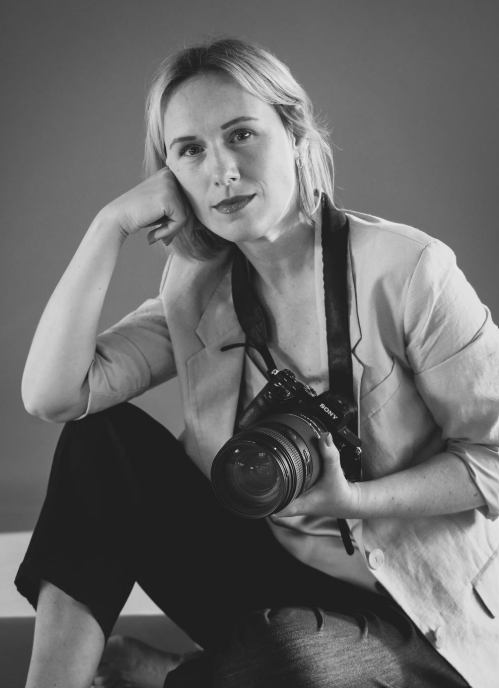
Photo: Lera Manzovitova by Elen Cherednikova.
It also showcases the significant efforts of the Dutch people in volunteering, donating, and supporting the treatment of wounded Ukrainian soldiers. Lera arrived in the Netherlands as a refugee in 2022 with her 9-year-old daughter. She had little more than two small suitcases, her daughter’s plush toy dog, and a camera. Initially uncertain about how to move forward, her journey took a decisive turn in 2022 when she photographed the Mother’s March of Ukrainian mothers in Amsterdam. That experience ignited her passion for documenting the lives of Ukrainians and their resilience in a new land.
For VATAHA, we spoke with Lera about her artistic journey and the story behind her first photo exhibition.
Can you tell us about the types of photography you focused on before the war? What motivated your work during that time?
Lera: Before the war, I specialised more in other types of photography: portraiture and family photography. Reporting was in my life mainly for volunteer purposes: I worked with cancer patient organisations, the project Not a Scary Book at All (dedicated to capturing the feelings of palliative care patients and their families). My family, unfortunately, went through several cases of cancer (including my mother). So even then, I intuitively came to the conclusion that being among like-minded people who have similar experiences, as well as contributing to socially important changes, makes you feel a little lighter yourself. Especially if you find yourself in a situation that you cannot change globally on your own: an incurable disease, a war.
Did your volunteer work influence how you approach sensitive subjects in your photography?
Lera: Greatly. For example, I was filming a project during which girls with cancer, surrounded by their colleagues who had gone into remission, had their heads shaved in a festive atmosphere (expecting their hair would not withstand chemotherapy)—a kind of act of support in a difficult psychological situation, which gives them hope for success in difficult treatment.
During such shootings, you don’t just capture the moment by clicking the camera button, but become part of the team that creates the mood. Actually, this interaction with different kinds of people and the opportunity to listen/encourage is what attracts me to social projects. It is both the fulfilment of my own need to do good and my personal motivation. Because sometimes, fate brings you together with people of incredible destiny and inner strength—it inspires you to overcome problems in your own life.
That’s why, for example, studio modelling is ‘not my thing’, because it’s a completely different type of photographic craft.
What kinds of challenges did you face when working in the Netherlands?
The biggest ethical dilemma in my work in the Netherlands that I faced was when I offered my own photographic volunteer services to the NL4UA Foundation (which takes care of Ukrainian veterans who are undergoing treatment and rehabilitation here). Ksenia Negrutsa (the founder) was worried: how would the soldiers react to the photographer? They had gone through a lot of pain, both physical and psychological; some of them were just adjusting to life after losing limbs and undergoing severe surgery on their faces. There were fears that the presence of a photographer at the foundation’s events would be unwelcome.
I explained that despite my professional reporting skills, respect for people has always been above all else for me. So I think I know how to navigate in the moment, to find the ‘key’ to the characters in the film to understand whether my actions are appropriate. Eventually, I was invited to a meeting of veterans to mark the first anniversary of the full-scale invasion. It was there that a miracle happened for the first time, and it grew stronger with each of our subsequent meetings: we became friends with the soldiers, we greeted each other warmly at every meeting, they shared the details of their treatment and ordinary moments of life. It warms my heart.
What brought you to the Ukrainian Mothers’ March in Amsterdam in 2022, and how did it shape your path as a photographer?
Lera: I just saw a call on social media and felt I had to be there. It was then that I started crying since February 2022. The whole month before that, I had been acting like a robot, trying to calculate the logistics first, when we jumped on the first train we could find to evacuate from Kyiv (it was then that the horrors in Irpin and Bucha were happening). Then, we had to figure out where to go next, because it was visible the war wouldn’t take ‘two weeks,’ and I had to provide for my child’s basic needs in a completely foreign country.
The crying of the mothers on the Dam Square, on both sides of the camera, became an act of unity and catharsis at the same time: I am sure that I was not the only one who felt like a metal spring compressed to the limit by this point…
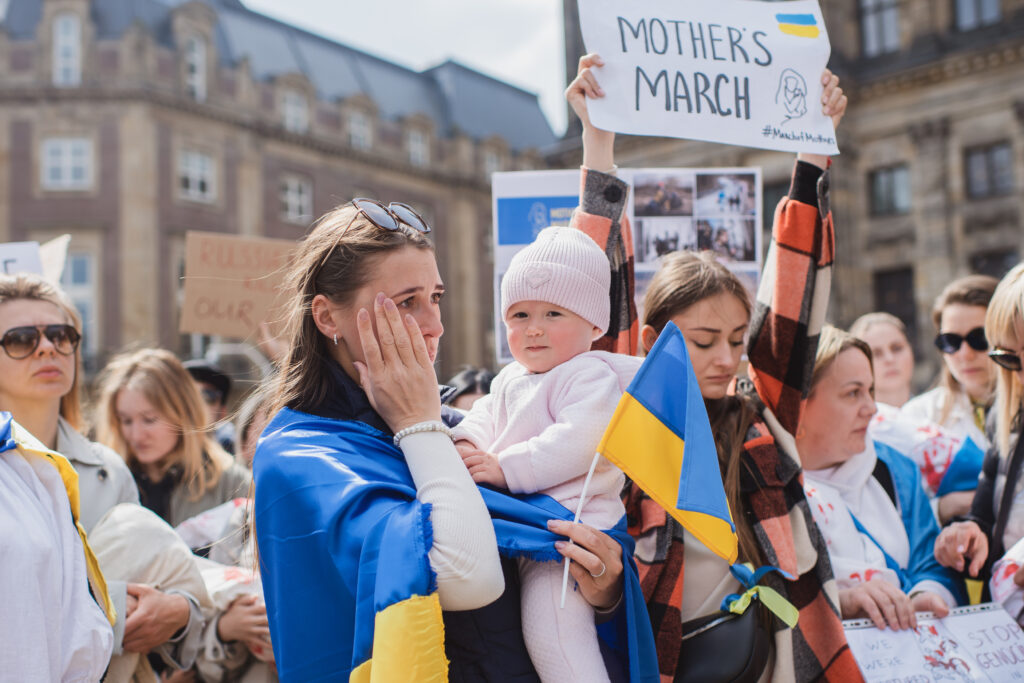
Photo: Lera Manzovitova. Mothers’ March in Amsterdam, 2022
How did this first photoshoot experience in the Netherlands evolve into an ongoing focus on documenting the Ukrainian community and their challenges?
Lera: Later, it turned out that recording such events was necessary in order to inform about the war in Ukraine even more, to attract local people to help, including through social media content. A friend once forwarded me a request from the Zeilen van Vrijheid Foundation for a photographer to take pictures of an ambulance convoy being sent to the frontline. Covering the activities of such organisations not only has an informational purpose but also a purely pragmatic one: attracting donors. That’s how I became one of the Ukrainian volunteers, and then, observing my activity, other organisations started asking for help. I would like to take this opportunity to thank everyone for their trust!
Share a bit about the Power of Unity exhibition itself. Personally I saw it as a unique blend of photography with text, showcased on specially designed panels. What is the central concept behind this innovative presentation?
I position the exhibition as a social photo-information project. Before I became a photographer, I worked in journalism for 10 years, so I decided to recall my previous experience (interviewing, editing) and not limit myself to just showing photos. The project took on the format of 15 panels with portrait and reportage photos, and most importantly, texts, which allowed key individuals and organisations to present their activities and share their own experiences of living through a difficult but heroic period. In the end, feats are not only performed on the frontline. We can also observe deeds of humanity, patriotism, and volunteerism among Ukrainians who find themselves abroad.


Photo: Lera Manzovitovas’ 2 panels out of 15 exhibited on the Power of Unity.
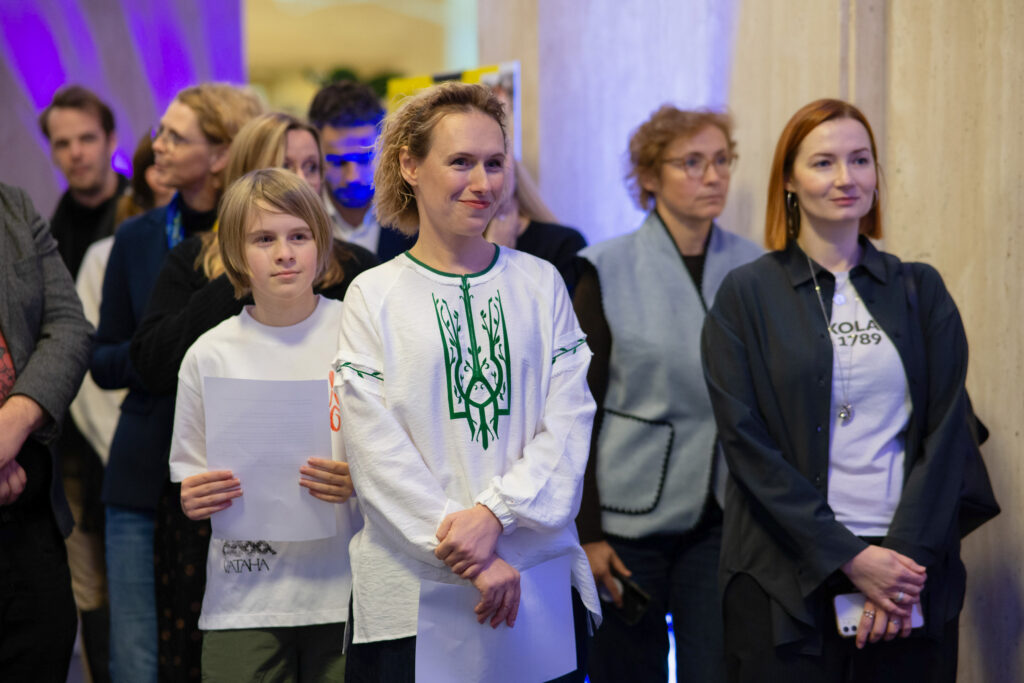
Photo: Exhibition opening of Power of Unity in The Hague.
On the one hand, the exhibition aims to remind us once again of the war in our country and the tragic aspects associated with it, and on the other hand, to show the cohesion, active position of our community and support of the Dutch.
Many leaders of volunteer organisations took part in the project. Among them: 1st Honorary Consul of Ukraine to the Netherlands Karel Burger Dirven, VATAHA Foundation, Stichting Zeilen van Vrijheid, Netherlands for Ukraine Foundation, military and trauma surgeon dr. Vicent Stirler, dr. Mirjam de Jong, dr. Niels Jonkergouw, Nijmegen4Ukraine, Open Door Ukraine, Ukrainian house in Maastricht, DroneAid Collective, Haarlem4Ukraine, Ko-Station, Stichting Oekraïense Club, Oekrainse school Wesselka, Stichting Vital’nya, Olga Korol from Empatia program by OPORA Foundation, United Way the Netherlands, Radio Ukraine The Netherlands, Maidan to Dam, Ukrainian veteran Andriy Danyo and Ukrainians in the Netherlands foundation.

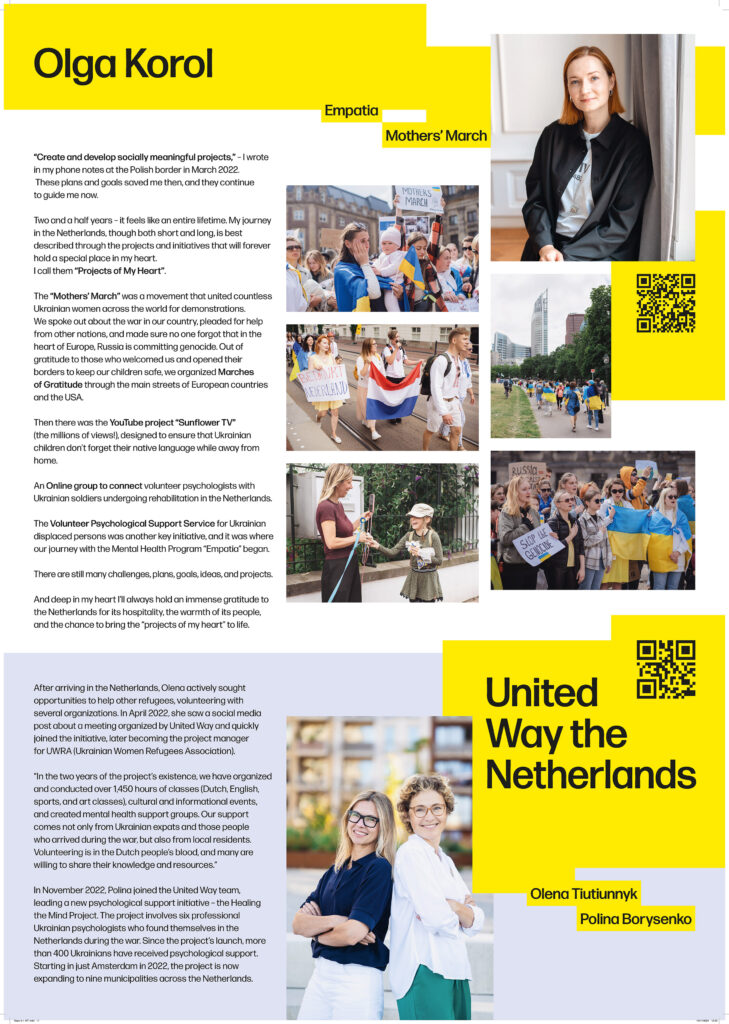
Photo: Lera Manzovitovas’ 2 panels out of 15 exhibited on the Power of Unity.

Photo: Exhibition opening of Power of Unity in The Hague.
I hope that both visitors and featured organisations, community leaders will receive not only emotional benefits from my exhibition but also practical ones. I am very grateful to designer Yaroslava Kolomiets for helping me with the exhibition and for her ideas: the panels contain not only photos and texts but also QR codes with links to the organisations’ websites. So everyone, who is willing to help Ukraine can join the team of volunteers, find out about the schedule of events, or help with a donation.
What kind of interaction with the visitors has stood out to you so far?
Lera: As for the audience’s emotions, one situation on the eve of the project presentation is quite illustrative. I was setting up the exhibition at the location with the ministry’s staff when we saw a Dutch couple looking at the panels with great interest. It turned out that they had come all the way from Groningen to visit the Ministry of Foreign Affairs, and the man (named Harry) is a volunteer who teaches Dutch to Ukrainians at a location. He asked for my business card, and a week later, I received a letter that really touched me. He was passionate about bringing the exhibition to as many local people as possible (e.g. libraries, universities, including his hometown) to increase understanding of the Ukrainian people, and describes it as follows:
‘I am impressed by the many different themes you raise. The photographs and texts are poignant, but also touching.
Even Andriy Danyo’s story reads like a story of hope.’
[Andriy Danyo is a veteran who lost two limbs and his eyesight in the war but found love – author’s note].
I guess I subconsciously wanted this duality of audience perception.
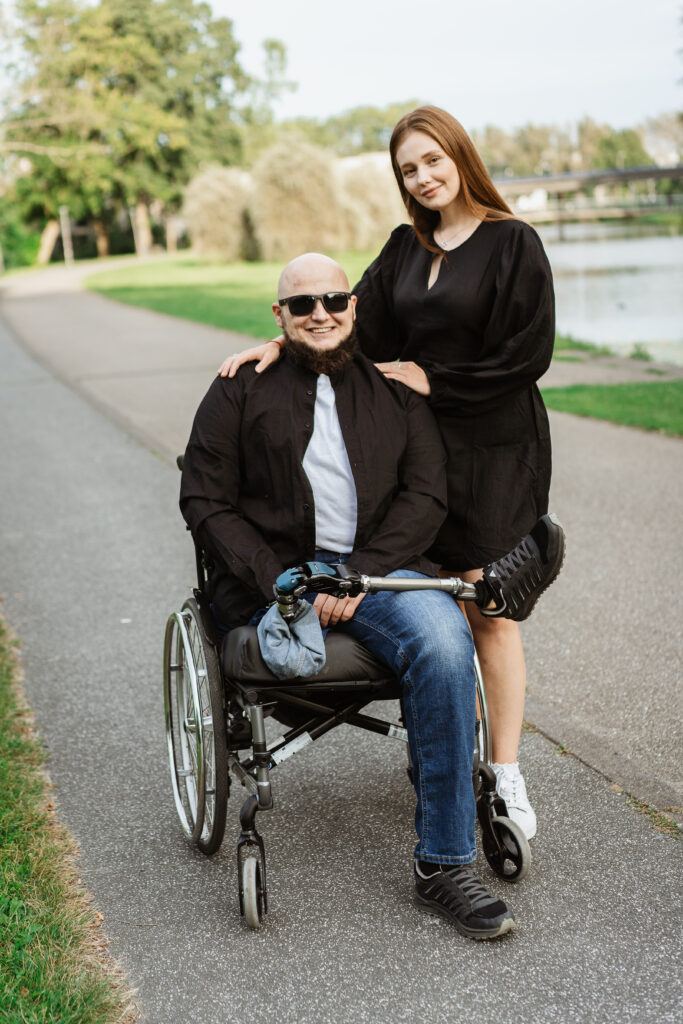
Photo: Lera Manzovitovas’ photoshoot of Andriy Danyo with his beloved.
Everything you’ve shared is truly inspiring, and the work you’re doing is remarkable. What’s next for you?
I am happy that the life of the project was not limited to exhibiting only in The Hague. I received an offer to participate in the Ontdek Oekraïne Festival (14 December 2024 to 5 January 2025, Nijmegen). I am also currently in talks to show this exhibition with two other locations in other cities in the Netherlands.
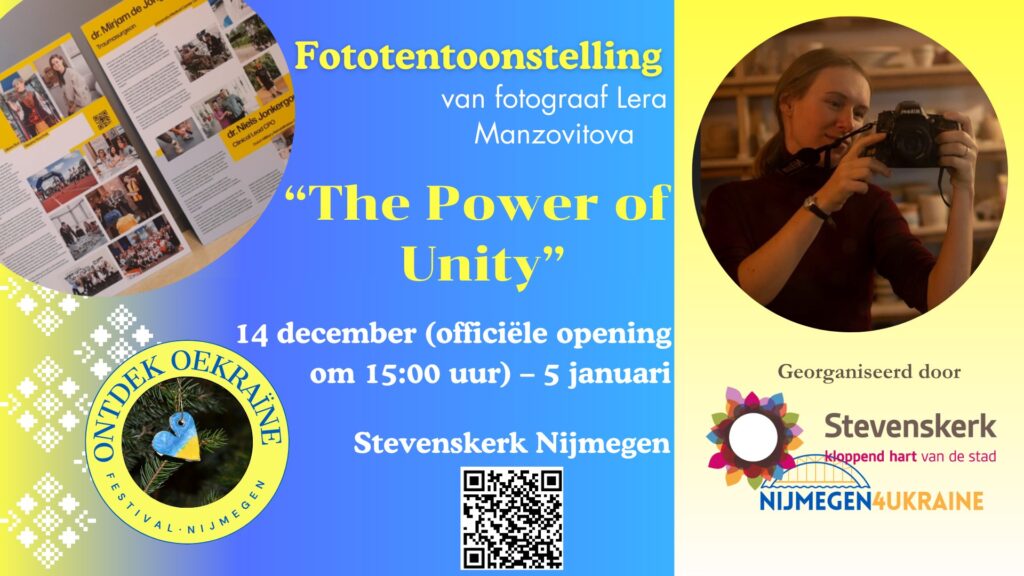
And, of course, I’m not stopping with my reporting activities! I’m happy to share that recently I received an official offer to join VATAHA, so now there will be more work full of new creative events and projects, and it’s great!
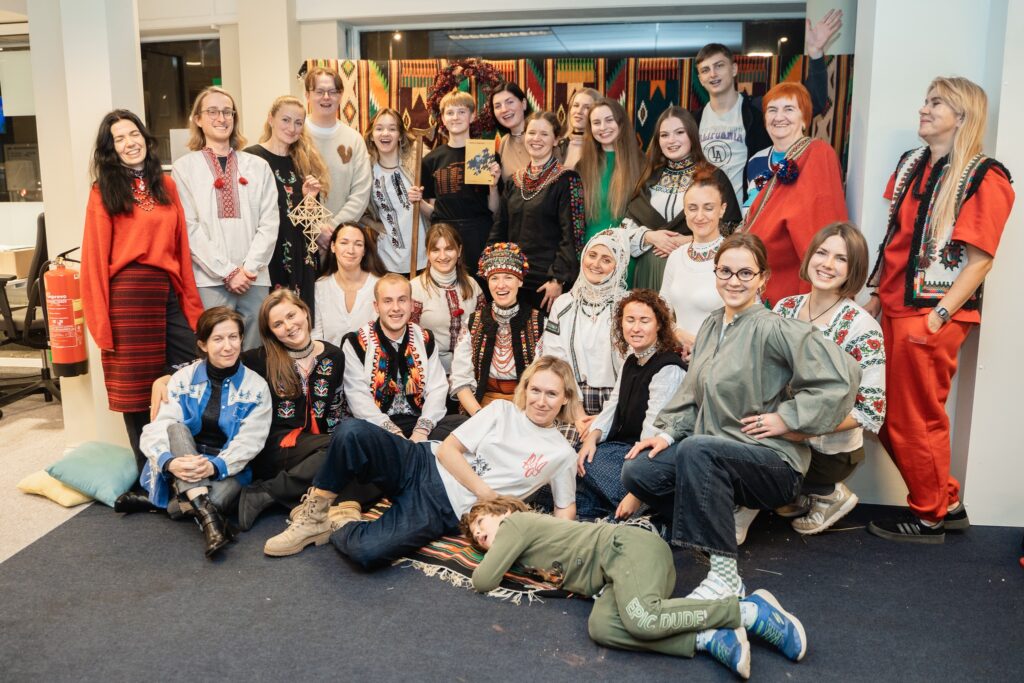
Photo: Lera Manzovitova as part of VATAHA
Lera Manzovitova’s exhibition is on display until December 13, 2024. Address: Atrium Ministry of Asylum and Migration, Turfmarkt 147, 2511 DP The Hague
Learn more about about Lera Manzovitova’s photography here.
____________________________________________________________________
Lera Manzovitova is a photographer from Kyiv, Ukraine. She has been pursuing photography professionally since 2015, following a decade of experience as a journalist and editor with organizations like Edipresse Group and Burda Media. Lera also has significant experience volunteering as a photographer for charitable organizations. She arrived in the Netherlands in late March, shortly after the full-scale Russian invasion of Ukraine.
To financially support VATAHA’s work to promote Ukrainian artists like Lera, you can make a tax-deductible contribution here!